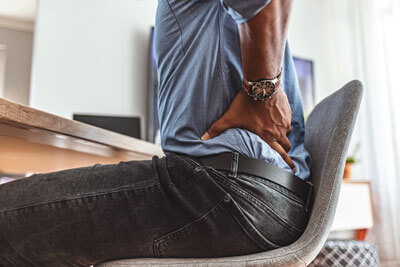Herniated Disc Treatment
 If you’ve ever experienced a herniated disc, you know how uncomfortable the pain can be. But what’s exactly going on that’s causing that pain?
If you’ve ever experienced a herniated disc, you know how uncomfortable the pain can be. But what’s exactly going on that’s causing that pain?
The spine consists of 24 small bones, known as the vertebrae, stacked on top of each other to create the spinal column. Between each vertebra is a soft cushion called a disc. It’s made up of two parts—on the inside is the nucleus pulposus, which is a jelly-like material, and the outer covering is made of annular fibers—to help absorb pressure and keep the bones from rubbing against each other.
The spinal column also has real joints (just like the knee or elbow or any other joints) called facet joints. The facet joints link the vertebrae together and give them the flexibility to move against each other.
What Causes Herniated Discs?
There can be several reasons for herniated discs. One of the most common is an automobile accident. The pressure the body is subjected to in a crash is tremendous. Whiplash moves the body forward and back suddenly, and may trigger or compress the disc, causing pain.
Improper curvature of the spine also puts an abnormal load on the discs. Pregnancy, excess weight, and repetitive motions can also cause problems. Whatever the cause, these issues disrupt or tear the annular fibers, creating instability, and allowing the jelly-like material to ooze out. If too much comes out, it can also impinge the nerve root.
When the fibers tear and the jelly becomes unstable, it’s known as a bulging disc. When the tear becomes larger and the disc protrudes through the fibers, it becomes a herniation.
Diagnosis and Correction
Symptoms of a herniated disc include
- Sharp pain
- Muscle spasms
- Weakness in the extremities
- Numbness or tingling
- Bowel disturbances
- Loss of sensation in the extremities
- Back pain
- And more
Getting Started and Care
The first thing we do at Midwest Sport and Spine is to put the patient through a thorough evaluation to determine if it’s a true disc herniation and not something more serious. We take X-rays to assess the structure of the spine for bone spurs or any other changes. Once we complete our diagnosis, we develop a care plan to address the patient’s needs. If we do not see improvement after several sessions, an MRI may be requested.
Typically, care will include decompression therapy and laser therapy. Pain shuts down muscle activity, so weak muscles need to be built back up with rehabilitative therapy. Chiropractic adjustments help with pelvic alignment and get the joints in the area to move properly to reduce stress. Pain relief may include Game Ready treatment, which includes ice, compression, and more.
We also have several adjunct services which we employ as needed, such as physical therapy and massage, to get the best possible results and speed healing. Early visits focus on pain relief and calming the disc irritation. Once that has been accomplished, we can focus on creating stability in the disc and speeding repair.
Answers for Your Pain
Pain from disc issues can be debilitating. We have solutions to ease the pain and start the healing process. Find out more about the therapies we have available, and get the relief you deserve. Call us today!

